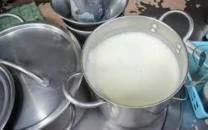East Europeans decry "double standards" for food, seek change to EU law
Multinational brands use different, often cheaper ingredients in food items sold on the east side of Europe

PHOTO: Reuters
Foreign brands quickly filled once-barren state stores in the east, but many still make the trip west - though no longer to window-shop but to buy what they believe are superior versions of the same brands they can find at home.
Ad hoc comparisons by media and lab tests show that some multinational brands use different, often cheaper ingredients in food items sold on the east side of Europe's old Iron Curtain divide than in products sold in adjacent Austria and Germany.
The practice is legal in the European Union, to which most eastern states now belong, as long as ingredients are declared. But central and eastern political leaders say it is unethical for products sold under the same brand to be inferior in quality in "new" EU member states compared with "old" member states.
The issue is now exercising the Visegrad Group of central and east European governments - Slovakia, the Czech Republic, Hungary and Poland - and they will meet in Warsaw on Thursday to prod Brussels for action against EU "double standards" in food.
They plan to raise the topic at a March 6 meeting of the EU's Agriculture Council in Brussels and call for an EU-wide solution that could involve changes to the bloc's consumer protection and food safety laws.
On one afternoon this week at a small shopping mall in Hainburg, a tidy Austrian town just up the Danube River from the Slovak capital Bratislava, about half of the parked cars bore Slovak license plates.
"I come here once a week to buy Austrian yoghurts, butter, salami and washing powder," said Livia, a 65-year-old shop assistant from the southwestern Slovak town of Dunajska Luzna.
Flour power lifts spirits as Greek village stages mock battle
"I don't hunt for the cheapest products, but the mid-range priced products in Austria have better quality than in Slovakia. You would expect that the products were the same, given that both countries are members of the EU."
Companies have explained differing composition of products sold in less competitive, poorer eastern markets by saying they are catering to local tastes and preferences.
"This is misleading to customers because (shoppers) expect the same product when they see the same packaging," food and agriculture analyst Petr Havel told Reuters.
He said producers have sometimes reduced the most expensive ingredients to keep food prices affordable - and protect their profit margins - in central and eastern EU countries where incomes remain lower than in the west and consumers conditioned by communist-era shortages long preferred quantity over quality.
"But this (attitude) has been slowly changing and people have been seeking higher quality products recently."
A Czech member of the European Parliament, Olga Sehnalova, brought the issue to public attention in 2015 when she presented a Prague University of Chemistry and Technology study of east-west differences in same-brand foods.
Visegrad governments seized on the findings, keen to show voters they are defending their interests against EU elites in Brussels often seen as distant from regional concerns.
Fish fingers to biscuits
Last month, Slovakia's Agriculture Ministry compared 22 same-brand products bought in Bratislava and in two Austrian towns across the nearby border and found half of them differed in taste, looks and composition. For instance, a German orange drink contained no actual juice, unlike the version sold in Austria.
Hungary's food safety authority examined 24 products sold in both Hungary and Austria. It found, among other things, that the domestic version of Manner wafers was less crunchy and the local Nutella not as creamy as the Austrian counterpart.
Subway disputes study claiming its oven-roasted chicken is only 50 per cent chicken
Reuters reporters found this week that Iglo Fish Fingers sold in Slovakia and Hungary had 58 percent fish content while the original in Austria, sold in identical packaging for virtually the same price, had 65 percent.
In Poland, Leibniz biscuits contain five percent of butter and some palm oil, while the same sold in their German home market contain 12 percent of butter and no palm oil, a cheaper alternative to butter.
Britain-based Nomad Foods Europe, the maker of Iglo Fish Fingers, said it adapts that product to reflect local taste and preferences and these were different from Austria.
"The fish fingers we sell in Hungary and Slovakia ... are exactly the same ones as we sell in the UK," Nomad Foods Corporate Affairs Director Sinead Noble told Reuters.
Manner, a family-owned Austrian company; Ferrero, the Italian producer of Nutella; and Bahlsen, the German maker of Leibniz biscuits, did not immediately reply to emailed questions from Reuters.
Foodmakers say differences in product ingredients are all permitted by EU consumer and food safety statutes.
"Consumers must be accurately informed and must not be misled as to the composition of the foods they buy," a European Commission spokeswoman said.
But that position does not wash for the EU Commissioner for Justice, Consumers and Gender Equality, Vera Jourova, a Czech.
"Dual quality of food products of the same brand in the member states is misleading, intolerable and unfair to consumers. I will do my best to stop it," she told Reuters.
"Europe's garbage can"
A poll last year commissioned by Prague's Agriculture and Food Inspection Authority found 88 percent of Czechs were bothered by varying compositions of food products for Czech and other markets, and 77 percent rejected the producers' argument that such differences were driven only by local preferences.
Czech Agriculture Minister Marian Jurecka said last week that people in central and eastern countries were tired of being "Europe's garbage can". The top aide to nationalist Hungarian Prime Minister Viktor Orban called dual food standards "the biggest scandal of the recent past".
Part of the reason for varying product composition has been continued lower purchasing power in formerly communist countries, where average household net disposable incomes are about half of those in affluent Austria.
Food prices on the whole are lower in each of the four Visegrad Group countries than in Austria and Germany, according to 2015 data compiled by the EU statistics office Eurostat.
Poland is by far the cheapest at 63 percent of the EU average, versus 120 percent of the average in Austria.
Still, many shoppers say they get higher quality for the same money when they pop into Austria or Germany, whatever the results of comparative tests done by government researchers.
A number of Czech websites offer shipments of what they describe as high-quality, cheaper products direct from German stores. Also in high demand across the region are German cosmetics and detergents.
For some Slovaks, shopping in Austria has become normal. "I would not eat a Slovak cheese anymore, I've got used to Austrian products," said Michael, an 11-year-old shopping with his 37-year-old mother Janette in Hainburg.
She thinks it is worth making the 140-km (87-mile) journey to Hainburg from their home in Trencin twice a month. "You can see the difference in the famous Milka chocolate. The Austrian version simply tastes better," she said.



















COMMENTS
Comments are moderated and generally will be posted if they are on-topic and not abusive.
For more information, please see our Comments FAQ